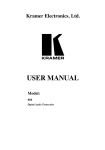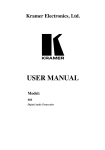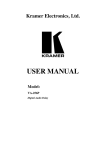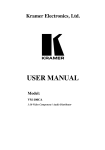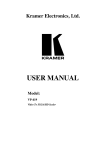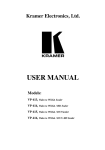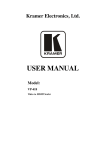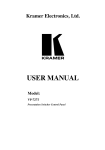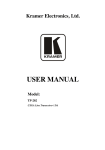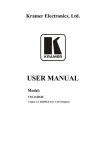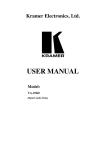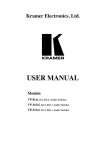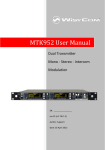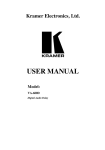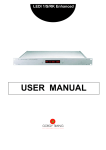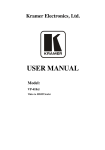Download USER MANUAL
Transcript
Kramer Electronics, Ltd. USER MANUAL Model: 466N Digital Audio Transcoder Contents Contents 1 2 2.1 3 3.1 4 5 6 6.1 7 Introduction Getting Started Quick Start Overview Shielded and Unshielded Twisted Pair Cables Your 466N Digital Audio Transcoder Connecting the 466N Digital Audio Transcoder Cascading Machines Using Additional 466N Machines Technical Specifications 1 1 2 3 4 5 8 10 12 13 Figures Figure 1: 466N Digital Audio Transcoder Figure 2: 466N Digital Audio Transcoder Underside Mode Selection Switch Figure 3: Connecting the 466N Digital Audio Transcoder Figure 4: Extending the Range with the 466N Digital Audio Transcoder 5 7 9 11 Tables Table 1: Features and Functions of the 466N Digital Audio Transcoder Table 2: 466N Underside Features Table 3: Technical Specifications of the 466N Digital Audio Transcoder 6 7 13 i Introduction 1 Introduction Welcome to Kramer Electronics! Since 1981, Kramer Electronics has been providing a world of unique, creative, and affordable solutions to the vast range of problems that confront the video, audio, presentation, and broadcasting professional on a daily basis. In recent years, we have redesigned and upgraded most of our line, making the best even better! Our 1,000-plus different models now appear in 11 groups1 that are clearly defined by function. Congratulations on purchasing your Kramer 466N Digital Audio Transcoder. This product is ideal for the following typical applications: Video production and duplication studios Audio recording studios Live broadcasting and editing The package includes the following items: 466N Digital Audio Transcoder Power adapter (5V DC) This user manual2 2 Getting Started We recommend that you: Unpack the equipment carefully and save the original box and packaging materials for possible future shipment Review the contents of this user manual Use Kramer high-performance high-resolution cables3 1 GROUP 1: Distribution Amplifiers; GROUP 2: Switchers and Matrix Switchers; GROUP 3: Control Systems; GROUP 4: Format/Standards Converters; GROUP 5: Twisted-Pair Solutions; GROUP 6: Specialty AV Products; GROUP 7: Scan Converters and Scalers; GROUP 8: Cables and Connectors; GROUP 9: Room Connectivity; GROUP 10: Accessories and Rack Adapters; GROUP 11: Sierra Products 2 Download up-to-date Kramer user manuals and software from our Web site at http://www.kramerelectronics.com 3 The complete list of Kramer cables is on our Web site at http://www.kramerelectronics.com 1 Getting Started 2.1 Quick Start This quick start chart summarizes the basic setup and operation steps. 2 KRAMER: SIMPLE CREATIVE TECHNOLOGY Overview 3 Overview The 466N is a high-performance transcoder for digital audio signals. It converts 1 of 4 digital audio formats or 1 twisted pair input to 4 digital audio formats and 2 twisted pair outputs simultaneously. The 466N has the following inputs and outputs: Professional balanced 110 AES/EBU on detachable terminal block connectors AES-3id 75 on BNC connectors Consumer 75 S/PDIF on RCA connectors Optical TOSLINK® in and out connectors One twisted pair input Two twisted pair outputs More specifically: When an input is selected, all the outputs are available simultaneously All inputs and outputs are capable of receiving and transmitting up to 24-bit, 192kHz digital audio, including multi-channel audio A twisted pair input and two identical twisted pair outputs enable an extensive cascade of branching to provide multiple outputs over a long distance The system bit can be set to professional or consumer status, while all the other system bits remain the same The 466N Digital Audio Transcoder: Can transmit the highest quality digital audio over several hundred meters when several 466N units are used – one as a transmitter and one or more as receivers Has transformer-coupled AES/EBU and AES-3id inputs and outputs Accepts all serial digital audio transmission standards, compliant with IEC 60958, S/PDIF, EIAJ CP1201 and AES/EBU interface standards, as well as multi-channel standards Is 5V DC fed and is housed in a DigiTOOLS® enclosure 3 Overview To achieve the best performance: Use only good quality connection cables1 to avoid interference, deterioration in signal quality due to poor matching, and elevated noise levels (often associated with low quality cables). Avoid interference from neighboring electrical appliances that may adversely influence signal quality and position your Kramer 466N away from moisture, excessive sunlight and dust Close the connectors of the optical cables (when not in use) to protect them against exposure to dirt and dust Caution – No operator-serviceable parts inside unit. Warning – Use only the Kramer Electronics input power wall adapter that is provided with this unit2. Warning – Disconnect power and unplug unit from wall before installing or removing device or servicing unit. 3.1 Shielded and Unshielded Twisted Pair Cables The decision whether to use shielded twisted pair cable or unshielded twisted pair cable depends on the nature of the application. In applications with high interference, shielded twisted pair cable gives better results. However, the shield itself creates a capacitance that degrades the frequency response of the machines. For shorter distances, of approximately 50 meters, shielded twisted pair cable is preferred because it provides protection from interference and degradation is non-apparent. For a long-range application, unshielded twisted pair cable is preferred. However, the unshielded twisted pair cable should be installed far away from electric cables, motors etc., which create electrical interference. 1 Available from Kramer Electronics on our Web site at http://www.kramerelectronics.com 2 For example, part number 2535-052002 4 KRAMER: SIMPLE CREATIVE TECHNOLOGY Your 466N Digital Audio Transcoder 4 Your 466N Digital Audio Transcoder Figure 1 and Table 1 define the 466N Digital Audio Transcoder, Figure 2 and Table 2 define the underside features: Figure 1: 466N Digital Audio Transcoder 5 Your 466N Digital Audio Transcoder Table 1: Features and Functions of the 466N Digital Audio Transcoder # 8 9 10 11 12 13 14 15 16 17 18 19 OUTPUTS TWISTED PAIR1 AES/ EBU 5 6 7 LOCAL INPUT SELECTOR 3 4 Feature 5V DC AES-3id BNC Connector S/PDIF RCA Connector ® OPTICAL TOSLINK Connector Function +5V DC connector for powering the unit Connect to the digital audio acceptor (75 ) Connect to the digital audio acceptor (S/PDIF) Connect to the optical audio acceptor OUT Detachable Terminal Block IN Detachable Terminal Block Connect to an additional 466N receiver Connect to an additional 466N receiver Connect to the OUT1 or OUT2 detachable terminal block on another (transmitter) 466N unit, when using more than one 466N unit (transmitter/receivers) Connect to the digital audio acceptor Connect to the digital audio source OPTICAL Button Press to select the optical input source S/PDIF Button Press to select the S/PDIF source OUT2 Detachable Terminal Block OUT1 Detachable Terminal Block IN Detachable Terminal Block AES-3id Button Press to select the AES-3id source AES/EBU Button Press to select the AES/EBU source TWISTED PAIR / LOCAL Push Button INPUTS 1 2 OPTICAL TOSLINK® Connector S/PDIF RCA Connector AES-3id BNC Connector ON LED LINK LED Release the button, to the LOCAL position, if a single unit is used, or the unit is to operate as a transmitter2 Push the button in, to the TWISTED PAIR position, if the unit operates as a receiver Connect to the optical audio source Connect to the digital audio source (S/PDIF) Connect to the digital audio source (75 ) Lights red when the system is powered Lights green when the input is connected and the signal is of good quality and can be decoded 1 When connecting a single machine, this section is not relevant 2 See Figure 4 6 KRAMER: SIMPLE CREATIVE TECHNOLOGY Your 466N Digital Audio Transcoder Figure 2: 466N Digital Audio Transcoder Underside Mode Selection Switch Table 2: 466N Underside Features # 20 Feature MODE SELECT Switch Function Slide up to set to PROF (professional) or slide down to set to CONSUMER to change the system bit1 1 For example, when connecting a consumer source (a DVD player) and outputting to a professional acceptor (a DAT recorder), it may be necessary to change the system bit status by altering the selected PROF./CONSUMER mode 7 Connecting the 466N Digital Audio Transcoder 5 Connecting the 466N Digital Audio Transcoder To connect a single 466N Digital Audio Transcoder machine, as the example in Figure 3 illustrates1, do the following2: 1. Connect the sources as follows: Connect a digital audio source (for example, a DAT player) to the AES-3id INPUT BNC connector Connect a digital audio source (for example, a DVD player) to the S/PDIF INPUT RCA connector Connect a digital audio source (for example, a DVD player) to the OPTICAL INPUT TOSLINK® connector Connect an AES/EBU source (for example, a DAT player) to the AES/EBU detachable terminal block IN connector using a shielded twisted pair cable 2. Connect the acceptors as follows: Connect the OPTICAL OUTPUT TOSLINK® connector to a digital audio acceptor (for example, an AV receiver) Connect the S/PDIF OUTPUT RCA connector to a digital audio acceptor (for example, an AV receiver) Connect the AES-3id OUTPUT BNC connector to a digital audio acceptor (for example, a DAT recorder) Connect the AES/EBU detachable terminal block OUT connector (using a shielded twisted pair cable) to an AES/EBU acceptor (for example, a DAT recorder) 3. Connect the 5V DC power adapter to the power socket and connect the adapter to the mains electricity. 4. Release the TWISTED PAIR/LOCAL button to the LOCAL position. 5. Set the MODE SELECT switch button to PROF. or CONSUMER, as required (see Figure 2). 6. Press one of the LOCAL INPUT SELECTOR buttons to select an input source3. This source appears on all outputs simultaneously. 1 You do not have to connect all inputs and outputs, connect only those that are required 2 Switch OFF the power on each device before connecting it to your 466N. After connecting your 466N, switch on its power and then switch on the power on each device 3 If the valid digital audio signal is present on the selected input, the green LINK LED lights 8 KRAMER: SIMPLE CREATIVE TECHNOLOGY Connecting the 466N Digital Audio Transcoder Figure 3: Connecting the 466N Digital Audio Transcoder 9 Cascading Machines 6 Cascading Machines You can cascade several machines via the TWISTED PAIR detachable terminal blocks (OUT1, OUT2, and IN), to extend the range of the output signals over several hundred meters. To use several machines1, as illustrated in Figure 4, do the following2: 1. Connect the first 466N unit (the Transmitter3 in Figure 4) as described in section 0. 2. Connect Receiver4 # 1 (in Figure 4): Connect the outputs, as described in section 5 Push in the TWISTED PAIR/LOCAL button to the TWISTED PAIR position Connect the TWISTED PAIR OUT 1 detachable terminal block, on the Transmitter, to the TWISTED PAIR IN detachable terminal block on Receiver # 1, via a shielded twisted pair cable Set the MODE SELECT switch button to PROF. or CONSUMER, as required (see Figure 2) 3. Connect Receiver4 # 2 (in Figure 4): Connect the outputs, as described in section 5 Push in the TWISTED PAIR/LOCAL button to the TWISTED PAIR position Connect the TWISTED PAIR OUT 2 detachable terminal block, on the Transmitter, to the TWISTED PAIR IN detachable terminal block on Receiver # 2, via a shielded twisted pair cable Set the MODE SELECT switch button on each 466N unit to PROF. or CONSUMER, as required (see Figure 2) 4. Press one of the LOCAL INPUT SELECTOR buttons to select an input source5. This source appears on all outputs simultaneously. To operate any of the connected units locally, connect the desired inputs to that unit and release the TWISTED PAIR/LOCAL button to the LOCAL position. 1 Switch OFF the power on each device before connecting it to your 466N. After connecting your 466N, switch on its power and then switch on the power on each device 2 You do not have to connect all inputs and outputs, connect only those that are required 3 This 466N unit is operating as a transmitter in this configuration 4 This 466N unit is operating as a receiver in this configuration 5 If the valid digital audio signal is present on the selected input, the green LINK LED lights 10 KRAMER: SIMPLE CREATIVE TECHNOLOGY Cascading Machines Figure 4: Extending the Range with the 466N Digital Audio Transcoder 11 Cascading Machines 6.1 Using Additional 466N Machines You can connect additional 466N units (operating as receivers) to further extend the output signal range. To use additional 466N machines, do the following: 1. Connect the required outputs1 to the newly added 466N receiver unit. 2. Connect the TWISTED PAIR OUT 1 and/or OUT 2 detachable terminal blocks of the previously connected unit, to the TWISTED PAIR IN detachable terminal block on the newly added unit, using a shielded twisted pair cable. 3. Push in the TWISTED PAIR/LOCAL button on the new machine, to the TWISTED PAIR position2. 4. Set the MODE SELECT switch button on each 466N unit to PROF. or CONSUMER, as required (see Figure 2). 5. Press one of the LOCAL INPUT SELECTOR buttons to select an input source3. This source appears on all outputs simultaneously. When connecting several machines, push in the TWISTED PAIR/LOCAL button on all receiver units, except for the transmitter unit. 1 You do not have to connect all the outputs 2 Push in the TWISTED PAIR/LOCAL button on each unit except for the first machine (to which the inputs are connected). 3 If the valid digital audio signal is present on the selected input, the green LINK LED lights 12 KRAMER: SIMPLE CREATIVE TECHNOLOGY Technical Specifications 7 Technical Specifications Table 3 includes the technical specifications: 1 Table 3: Technical Specifications of the 466N Digital Audio Transcoder INPUTS: 1 digital audio AES-3id on a BNC connector, 1 S/PDIF digital audio on an RCA ® connector, 1 TOSLINK optical, 1 balanced digital audio AES/EBU on a detachable terminal block, 1 twisted pair on a detachable terminal block OUTPUTS: 1 digital audio AES-3id on a BNC connector, 1 S/PDIF digital audio on an RCA ® connector, 1 TOSLINK optical, 1 balanced digital audio AES/EBU on a detachable terminal block, 2 twisted pairs on detachable terminal blocks SAMPLING: 32, 44.1, 48, 96, 192kHz sampling frequencies STANDARDS: IEC 60958, S/PDIF, EIAJ CP1201 and AES/EBU interface standards, as well as multichannel standards CONTROL: Input select, local or twisted-pair selector, system bit selector POWER SOURCE: 5V DC, 60mA DIMENSIONS: 12cm x 7.5cm x 2.5cm (4.7" x 2.95" x 0.98") W, D, H WEIGHT: .25 kg (0.6 lbs.) approx. ACCESSORIES: Power supply, mounting bracket OPTIONS: RK-T1 or RK-T3 19” rack adapters 1 Specifications are subject to change without notice 13 14 For the latest information on our products and a list of Kramer distributors, visit our Web site: www.kramerelectronics.com where updates to this user manual may be found. We welcome your questions, comments and feedback. Safety Warning: Disconnect the unit from the power supply before opening/servicing. Caution Kramer Electronics, Ltd. Web site: www.kramerelectronics.com E-mail: [email protected] P/N: 2900-000411 REV 1

















